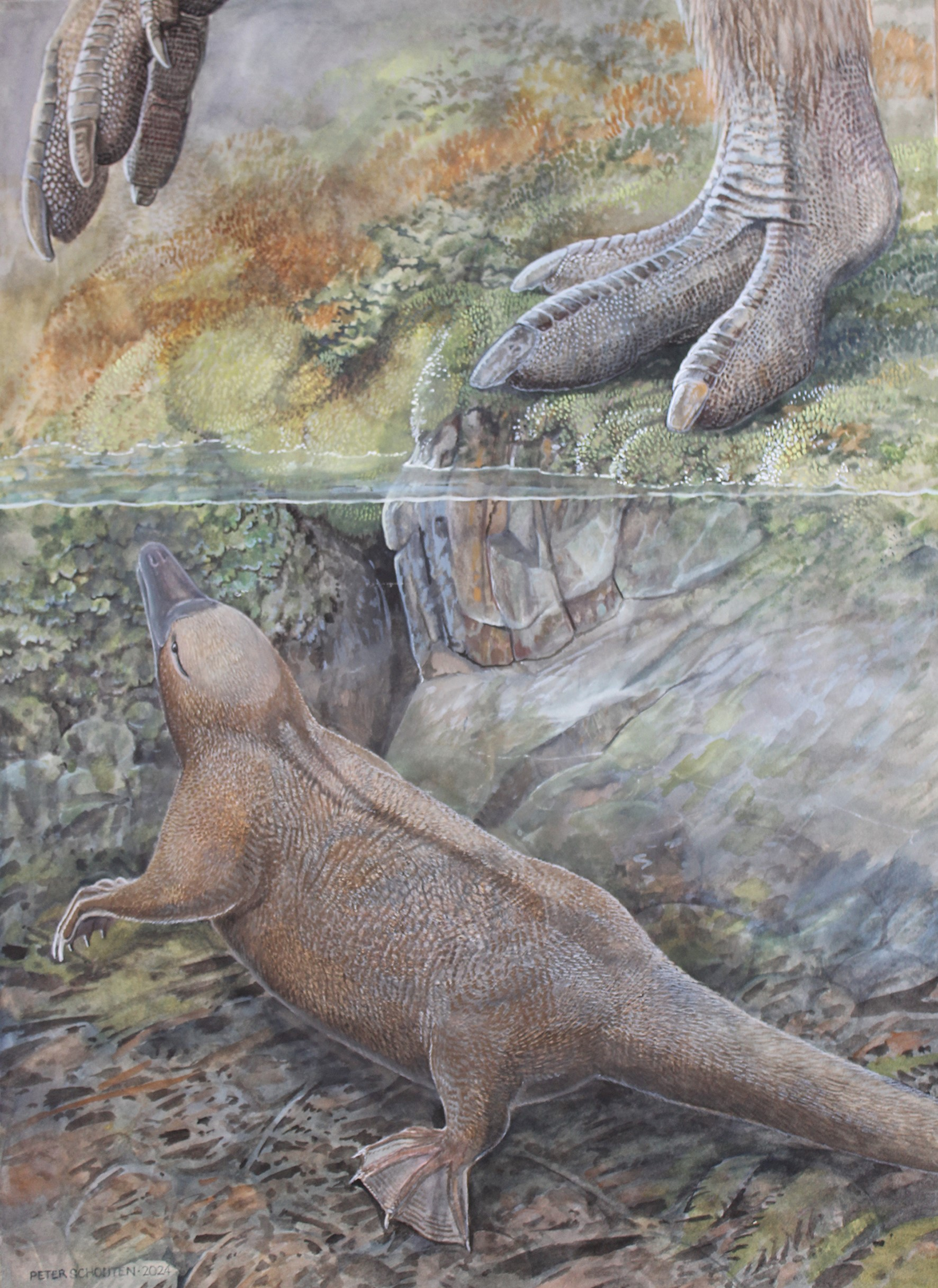An analysis of the interior of a single bone suggests its owner was probably an aquatic or semi-aquatic animal. Since the bone has been proposed to come from an ancestor of echidnas, or at least a relative, the finding raises the possibility that the common ancestor of all monotremes had a lifestyle more like a platypus than an echidna. This would be surprising, because it’s so rare for mammals that have adapted to the water to return to a purely land-based lifestyle, but it would explain some of echidnas’ strange traits.
Monotremes are oddities among mammals, with just one species of platypus and four echidnas laying eggs, as against thousands of species that give birth to live young. It’s been that way for a very long time, but in the age of the dinosaurs, it is thought that most Australian mammals were monotremes. However, the Australian continent is so bad at preserving fossils, and New Guinea so poorly studied, that monotreme fossils are even scarcer, relatively speaking, than surviving species. Consequently, we know very little about their evolutionary history.
In that context, the single bone from the species Kryoryctes cadburyi takes on a giant significance. It’s a humerus – an arm bone joining what would be the shoulder and elbow in humans. Externally, it looks more like a modern echidna’s arm than that of a platypus. The bone is 108 million years old and was found in southern Australia’s early Cretaceous “slippery rocks” at Dinosaur Cove in the early 1990s. The timing of the separation between the surviving monotreme species is uncertain, so Kryoryctes could be a common ancestor of both, a representative on the echidna line, or an evolutionary dead end that branched off from both major monotremes.
“While the external structure of a bone allows you to directly compare it with similar animals to help work out the animal’s relationships, the internal structure tends to reveal clues about its lifestyle and ecology,” Professor Suzanne Hand of the University of New South Wales (UNSW) said in a statement. “So the internal structure doesn’t necessarily give you information about what that animal actually is, but it can tell you about its environment and how it lived.”
With only one specimen ever found, any sort of damaging examination is unthinkable, so Hand and colleagues used a CT scan and other non-destructive techniques to explore inside.
The authors found a bone with thick walls, much heavier than those of echidnas, leaving little room for bone marrow. That’s not only similar to the internal structures of platypus bones, but resembles other semi-aquatic mammals, who use their heavy bones as ballast to dive for food.
This makes it likely that the common monotreme ancestor was semi-aquatic. Echidnas must then have made the rare move of adapting to the land.

Kryoryctes cadburyi in its environment, hiding from dinosaurs.
Image credit: Peter Schouten
“The bill of the platypus is well known to have lots of highly sensitive receptors that detect tiny electrical currents generated by prey,” Hand said. “And while the beak of the echidnas has fewer receptors, people have suggested that these receptors are a leftover of their platypus-heritage, as are remnants of the platypus bill that can be found in the beak of echidna embryos.” In this context, the echidna’s past may have made them well-suited to their current ant-eating niche, with just enough receptors to pick up insect activity.
Echidnas are also known for having their hind feet on backwards, which gives them their adorable waddle. This is considered useful for their burrowing lifestyle, but platypuses use the same orientation to swim better. It might even be said that echidnas swim through sand.
Another echidna feature Hand notes that may hark back to an aquatic ancestry is their positively charged proteins called myoglobin, which hold onto oxygen longer than hemoglobin. This allows aquatic mammals longer gaps between coming up for air. Once again, this may be a trait useful enough for a burrowing animal that it’s been maintained for tens of millions of years, but the pressure to evolve it in the first place was probably stronger in the water.
Although these observations are consistent with the aquatic echidna theory, there is still a lot of weight resting on that one bone we don’t even know for sure was from an echidna ancestor. Hand and co-authors have plans to examine the specimen in further non-destructive ways, but are also hoping to expand the sample.
In addition to monotreme fossils being rare, they’re also very unrepresentative. Most of the monotreme fossils we do have are teeth, or sometimes jaws. As the authors note, this makes unravelling the relationships between ancestors and living species particularly difficult “because none of the living species retains functional teeth.”
“This is one of the reasons why we’re increasing our efforts to help investigate the Mesozoic opalised fossils of Lightning Ridge, NSW, which are about the same age as the Victorian fossil deposits,” said UNSW’s Professor Mike Archer. If any such fossils are found, they might be gloriously beautiful as well as potentially very revealing.
In case you’re wondering, Kryoryctes cadburyi is indeed named after the chocolate company, proving you too can have a species name honor you if you sponsor an underfunded research team and a bone has a color reminiscent of your products.
The study is published in Proceedings of the National Academy of Sciences.
Source Link: Just One Bone Hints That Echidnas’ Origins May Lie In Water